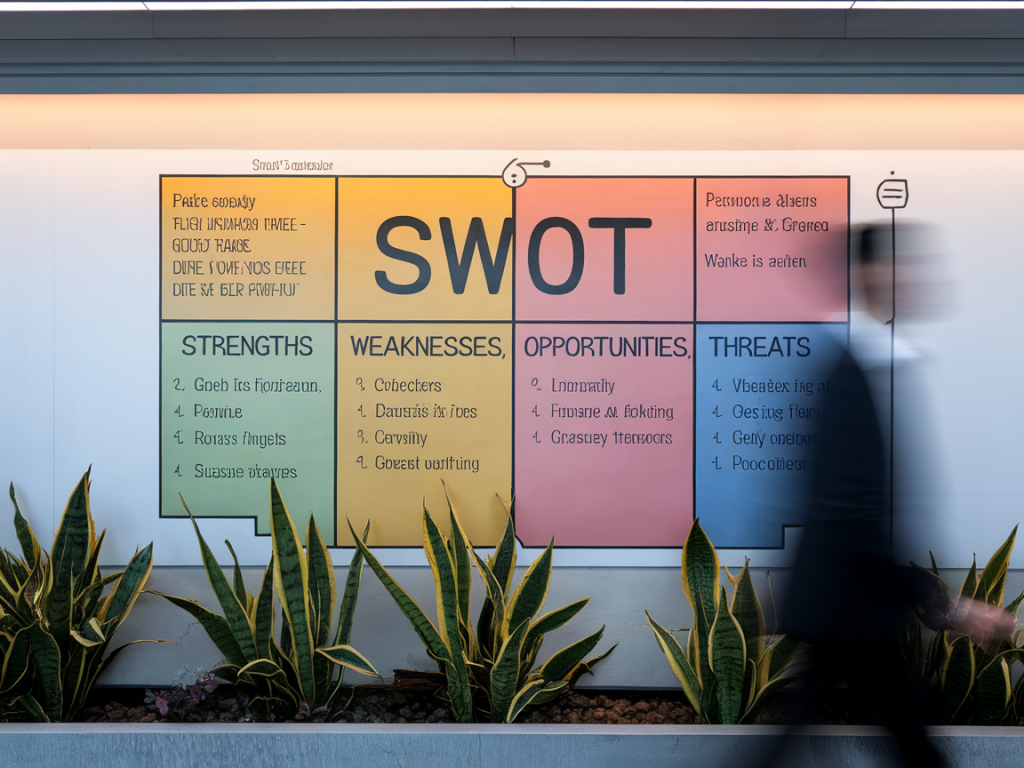
Understanding the Purpose of a SWOT Analysis
As business leaders, entrepreneurs, or decision-makers, we’re often tasked with deciphering complex scenarios to make informed decisions. One of the most tried-and-true tools for navigating these challenges is the SWOT analysis. However, let’s be honest—how many times have you conducted a SWOT analysis that ended up collecting dust in a folder rather than providing guidance for tangible actions?
A SWOT analysis—an evaluation of your Strengths, Weaknesses, Opportunities, and Threats—can be a powerhouse if approached correctly. But the key lies in transforming it from a static exercise into a strategic driver of decisions. Today, I’ll walk you through the steps to conduct a SWOT analysis that not only paints a clear picture of your business landscape but also translates directly into actionable strategies.
Preparing for a Truly Effective SWOT Analysis
Before diving into the exercise, it’s essential to set the groundwork. A SWOT analysis isn’t something you should do solo with a notepad over coffee. Instead, it’s best approached as a collaborative effort that includes input from team members across various departments. This brings diverse perspectives to the table and reduces the risk of blind spots.
Another critical consideration is defining your objective. Are you trying to grow your business, launch a new product, fend off competition, or pivot to a new market? Knowing your primary goal will provide focus and ensure your SWOT analysis remains relevant to your needs.
Breaking Down the SWOT Categories
Strengths
Your strengths are the internal factors your organization excels at. This is your opportunity to identify what gives you a competitive edge. For instance, do you have a well-established brand presence like Nike? Is your team highly innovative, or do you have proprietary technology?
A helpful tip is to think beyond the obvious. Sure, you might consider your loyal customer base or unique product features your strengths, but don’t forget to examine things like organizational culture or operational efficiency, which also contribute to long-term success.
Weaknesses
No business is perfect, and that’s okay. Weaknesses highlight areas for growth. Perhaps your customer retention rate isn’t as high as you’d like, or your supply chain isn’t as streamlined as it could be. Weaknesses might also include skills gaps within your team or a heavy reliance on a single revenue stream.
The key is to approach this section with honesty and a willingness to improve. Sugarcoating the reality of your weaknesses will defeat the purpose of the exercise.
Opportunities
Opportunities can be external factors that align with your strengths or address your weaknesses. For example, is there an untapped market segment that aligns with your product offering? Are there emerging trends—like the growing interest in sustainable practices—that you could leverage?
Keep an eye on industry reports, market data, or even your competitors’ strategies to identify potential opportunities. Platforms like Statista or tools like Google Trends can provide useful insights for this part of your analysis.
Threats
Threats are external challenges that could hinder your growth or stability. These could include new competitors entering your market, regulatory changes, or shifts in consumer behavior. For example, the rise of digital streaming was a major threat for DVD rental businesses like Blockbuster, paving the way for companies like Netflix.
While it can be daunting to identify potential threats, doing so enables you to develop preemptive strategies to mitigate their impact.
Translating Insights into Action
Here’s where many SWOT analyses fall short: After filling out the quadrants, the results are left hanging without a clear plan for execution. To ensure your SWOT analysis drives decisions, use these insights to create actionable strategies. Here’s how:
- Leverage Strengths: Look at your strengths and think about how you can leverage them to capitalize on opportunities or reduce weaknesses. For instance, if you have a strong social media presence, use it to promote a new product launch targeting emerging market trends.
- Improve Weaknesses: Identify weaknesses that are most critical to address. Create an action plan to mitigate them, whether that involves investing in staff training, upgrading your technology, or improving customer service processes.
- Capitalize on Opportunities: Turn opportunities into executable projects. If you’ve identified increased demand for sustainable products, consider incorporating eco-friendly materials into your production or marketing.
- Defend Against Threats: Develop contingency plans or mitigation strategies for threats. For example, if regulatory changes are on the horizon, consult with legal advisors to prepare your business for compliance.
Visualizing Your Findings
To keep your analysis clear and actionable, consider organizing it in a table format. Here’s a sample layout:
| Strengths | Weaknesses |
|---|---|
| Strong brand awareness | Limited online presence |
| Innovative team | High operational costs |
| Opportunities | Threats |
| Growing demand for eco-friendly products | Increasing competition |
| Untapped international markets | Economic downturn risks |
Having everything laid out visually can make it easier to identify connections between the quadrants and develop coherent strategies.
Making Your SWOT Analysis a Continuous Process
A single SWOT analysis is rarely enough. The market is dynamic, and so is your business. Set a schedule to revisit and update your analysis regularly, perhaps every quarter or after significant industry events. By making SWOT an ongoing practice, you’ll stay agile and better equipped to adapt to new challenges and opportunities.
The goal of conducting a SWOT analysis isn’t to check a box—it’s to create a living, breathing strategy that actively shapes your decisions. When used properly, this tool can provide clarity, foster creativity, and give you the confidence to act decisively in today’s fast-paced business environment.
